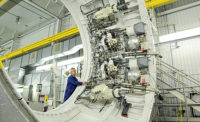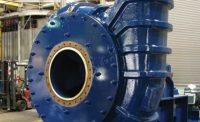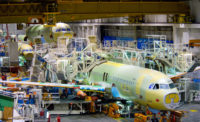Demand-Driven Manufacturing Keeps ATK Workers in Sync

Assemblers at Orbital ATK’s aerospace structures division in Clearfield, UT, build the composite frames for the Boeing Co.’s 787-9’s center and aft fuselages. Photo courtesy Boeing Co.

When a production problem arises anywhere in the Orbital ATK facility, SyncAlert software automatically sends an email or text message to identified responders to reduce downtime. Photo courtesy Synchrono Inc.


When pilots fly the Boeing Co. Dreamliner 787-9 over Utah, they probably don’t point out to passengers the headquarters of Orbital ATK’s aerospace structures division (ASD) in the town of Clearfield. Nevertheless, it’s safe to assume they’re happy the facility is there.
The reason is because ASD workers carefully assemble the composite frames for the 787-9’s center and aft fuselages. Assemblers at ASD also build composite stringers (structural members) and frames for the Airbus A350 XWB-1000, and later this year, they will begin making composite frames for the 787-10 airplane (set to commercially launch in 2018).
A few years ago, ASD plant managers decided to implement a demand-driven manufacturing software platform to help plant personnel better handle the company’s growing commercial aircraft business. The software platform is made by Synchrono Inc. and includes SyncOperations, SyncManufacturing, SyncView and SyncAlert software.
Brian Andrus, IT director at ASD, says platform installation took 13 months and has enabled the company to cost-effectively transition to a high-volume, high-mix manufacturing model. Without the platform, the switch would have cost ASD many more millions of dollars, including the expense of manually managing more than 300,000 transactions per month through the supply chain.
According to Andrus, the platform synchronizes the company’s workforce, methods, machines and work cells, and enables all staff personnel to access real-time performance data on demand. This latter capability, especially, has greatly improved workflow and plant efficiency.
All equipment, worker and business-system data is accessed and analyzed from a single source by SyncOperations, which simultaneously feeds it to SyncManufacturing and SyncView. Sync-Operations lets ASD managers quickly design workflows that comply with the company’s standard operating procedures. The software also uses the data to calculate overall equipment effectiveness to help ASD’s maintenance teams.
SyncManufacturing simplifies production scheduling by letting managers use a single operator interface rather than multiple screens and systems. When orders are received, SyncManufacturing
calculates materials, production availability and constraints, and prioritizes the entire order-to-delivery cycle.
SyncView is the platform’s visual factory information system. It lets each worker display real-time data the way he wants to see it, using charts, graphs, and role-based, workcell-based or custom dashboards.
“On a daily basis, leadership walks the factory together, stopping at each workcell to discuss production topics with operators while viewing the display boards produced by SyncView,” explains Andrus. “These boards give both leadership and operators the ability to show and monitor metrics and other information related to the core ASD key performance indicators: safety, quality, delivery, employee and cost. We can step in before any of these are compromised.”
When a production problem arises anywhere in the facility, SyncAlert automatically sends an email or text message to identified responders to reduce downtime. The software also tracks response time.
“We had an overall objective to reduce costs, enable growth and provide a path for scalable continuous improvement,” concludes Andrus. “What we ended up experiencing was a complete transformation of our processes to help us meet short-term goals and begin to realize our long-term vision for the future.”
For more information on demand- driven manufacturing software, call 651-228-1772 or visit www.synchrono.com.
Looking for a reprint of this article?
From high-res PDFs to custom plaques, order your copy today!








